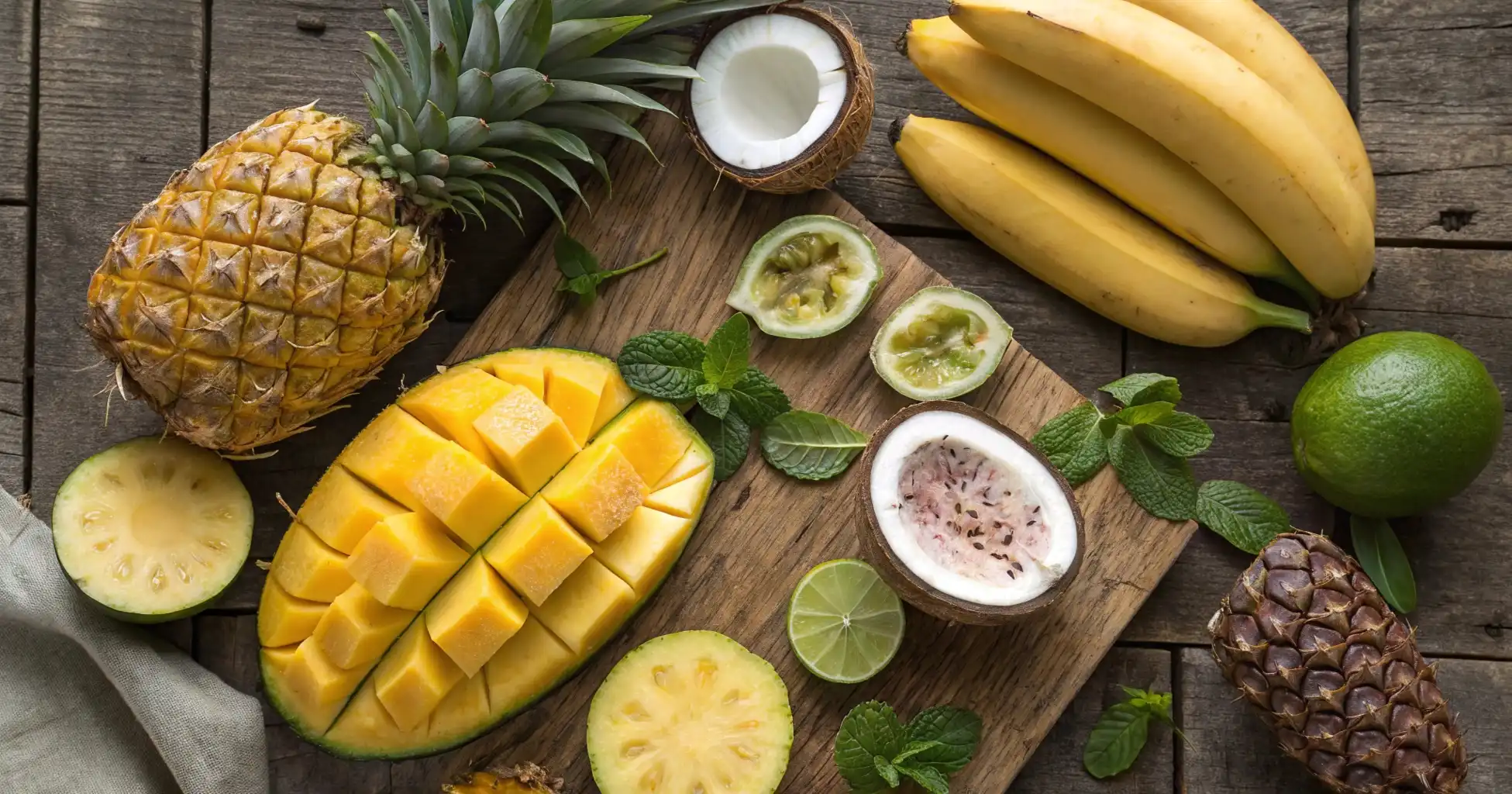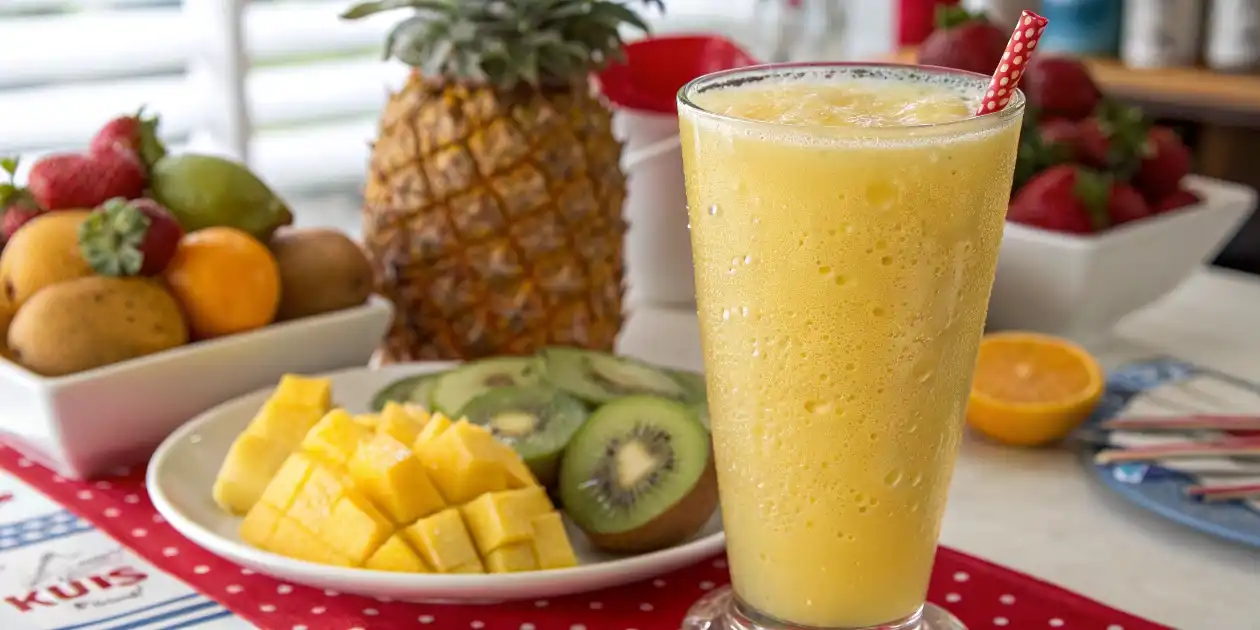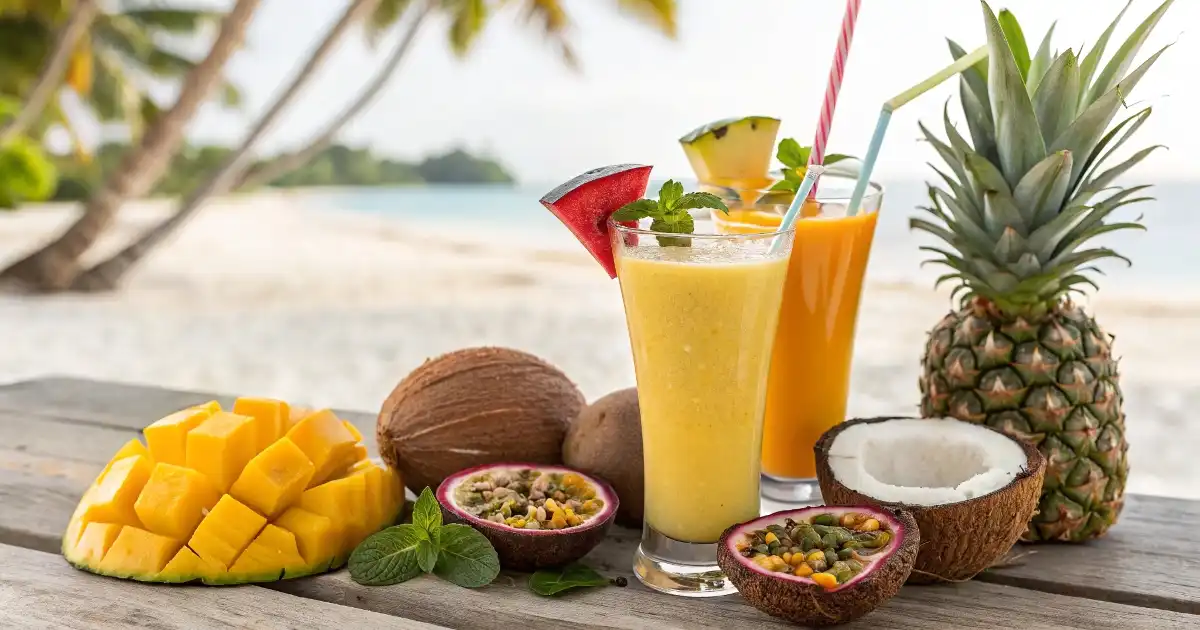Tropical juice is a refreshing blend of exotic fruits that brings the sun-kissed flavors of the tropics straight into your glass. It often combines fruits like pineapple, mango, papaya, or passion fruit to create a sweet, tangy balance. Enjoyed worldwide, tropical juice can be homemade, store-bought, or customized at local juice bars to fit your preferences.

Table of Contents
Introduction
Have you ever tasted tropical juice and felt like you were in a breezy beach paradise? For many, it’s more than a drink—it’s a mini vacation in a glass. Whether you’re a devoted fan or a curious beginner, you’re about to explore the delightful ways to enjoy and personalize this island-inspired beverage.
In this guide, you’ll learn how tropical juice can kick-start your mornings, cool down your afternoons, and add fun to your weekend gatherings. We’ll cover what makes it unique compared to regular juice, how to choose the best ingredients for flavor and health, and offer tips for creating your own blends along with top recipes. Ready to set off on a juicy adventure from Costa Rican pineapple groves to Indian mango orchards? Let’s dive in!
Disclaimer: This article is for informational purposes only and does not replace the advice of a physician. Always consult a trusted healthcare provider if you have any nutritional concerns or specific health issues before changing your diet.
What Exactly Is Tropical Juice?
At its core, tropical juice is any fruit-based beverage featuring exotic or tropical fruits, typically found in warmer climates. While classic fruit juices might focus on apples, oranges, and grapes, tropical juice draws on nature’s vibrant rainbow of fruits like mango, passion fruit, pineapple, papaya, guava, and more. These fruits thrive in areas with abundant sunshine, hot temperatures, and humid conditions—giving them the sweet, full-bodied flavor that sets tropical juice apart from its more temperate counterparts.
Common Tropical Fruits in Tropical Juice
- Mango: Known for its sweet, creamy taste and vibrant orange color.
- Pineapple: Tangy, bright, and known for its hint of acidity that balances the sweetness in tropical juice blends.
- Papaya: Buttery smooth texture and subtle sweetness.
- Guava: Fragrant aroma with a unique, slightly floral flavor.
- Passion Fruit: Tart, exotic, and bursting with a citrusy punch.
When you combine these fruits into one luscious blend, you get a tropical juice that practically sings with flavor. Think of it as a fruit salad in beverage form—only more vibrant and refreshing. Each fruit has its own nutritional profile, often brimming with vitamins A, C, and E, as well as key minerals like potassium and magnesium. According to the U.S. Department of Agriculture (USDA), fruit juices can contribute essential nutrients to your diet when consumed in moderation and paired with other healthy eating habits.
Why Tropical Juice Feels Like a Vacation in a Glass
Imagine the sensation of sipping on something that tastes like a Caribbean sunset. Tropical juice offers that moment of bliss any time you need a break from your busy schedule or the monotony of everyday life. Because these fruits are grown in places like Hawaii, Southeast Asia, the Caribbean, and Latin America, each sip of tropical juice hints at sandy beaches, warm breezes, and laid-back island life.
Emotional Benefits
- Stress Relief: The bright, fruity taste can help you relax and conjure uplifting memories of leisure and adventure.
- Sense of Luxury: Even if you’re at home in sweatpants, a glass of cool tropical juice can make you feel pampered and fancy.
- Nostalgia: If you’ve traveled to tropical regions before, the flavors can transport you back to your favorite vacation memories.
Cultural Connections
- Many cultures celebrate tropical fruits in their traditional cuisines and beverages.
- Enjoying a tropical juice blend might be a fun way to experience a slice of global culture without leaving your kitchen.
- Different regions have their own twist on tropical juice—for instance, Agua de Jamaica (hibiscus tea) and tamarind juice in Latin America, or fresh sugarcane juice in Southeast Asia.
A Brief History of Tropical Juice
People have enjoyed fruit-based beverages for centuries, especially in areas abundant with fresh produce. Historically, fruit juice was more of a luxury than a staple because early preservation methods couldn’t always keep it fresh. In warmer climates, though, local populations found ways to enjoy fresh tropical juice daily, often by blending fruit with water or even coconut milk. Over time, as global trade routes expanded, travelers and merchants introduced exotic fruits to new markets. Suddenly, the rest of the world got a taste of these luscious, sun-kissed flavors.
It wasn’t until advancements in refrigeration and pasteurization that tropical juice could be shipped worldwide without quickly spoiling. Modern consumers can now enjoy packaged tropical juice from nearly any supermarket, but nothing beats sipping a freshly made glass at a local stand in a tropical country. Whether it’s freshly pressed sugarcane juice in India or a chilled glass of passion fruit juice in Brazil, these beverages have long been cherished for their refreshing qualities and the cultural pride they represent.

Crafting Your Own Tropical Juice at Home
One of the best ways to indulge in tropical juice is to prepare it yourself. This approach lets you control the fruit combinations, sugar levels, and even the thickness of the juice. Some people love to include a few ice cubes or crushed ice for an instantly cooling effect, while others prefer a more smoothie-like consistency by blending in bananas or coconut meat. Here’s a simple step-by-step guide:
- Choose Your Fruits: Pick 2–3 tropical fruits that complement each other. A popular combo includes mango for sweetness, pineapple for tang, and a few chunks of papaya for body.
- Prep Your Ingredients: Wash, peel, and chop the fruits into smaller chunks to make blending easier.
- Add Liquid: Depending on your preference, add some water, coconut water, or a splash of orange juice. If you’re going for a thick smoothie texture, reduce the liquid.
- Blend: Using a blender, combine your chosen fruits and liquid. Pulse until you reach your desired consistency.
- Taste and Adjust: Need more sweetness? Add some ripe banana or a tiny spoonful of honey. Too thick? Add a bit more water or coconut water.
- Chill or Serve Immediately: Tropical juice is best enjoyed cold, so pop in a few ice cubes or chill it in the fridge.
Pro Tips for a Perfect Blend
- Use Ripe Fruits: The riper the fruit, the sweeter your tropical juice will be—without needing extra sugar.
- Experiment with Herbs and Spices: Try adding a leaf of mint or a dash of ginger. These can complement the natural fruit flavors and elevate your tropical juice.
- Strain for Smoothness: If you dislike pulp, strain the juice through a fine mesh sieve or cheesecloth.
Health Benefits and Nutritional Considerations
While tropical juice can be a sweet treat, it also offers valuable nutrients that benefit your body. Depending on the specific fruit blend you choose, you could be enjoying high levels of vitamin C, vitamin A, potassium, and antioxidants. Many tropical fruits, like papaya and pineapple, contain digestive enzymes (papain and bromelain, respectively) that might support gut health. However, it’s important to remember a few best practices.
Moderation Matters
- Sugar Content: Tropical fruits can be high in natural sugars. If you’re watching your sugar intake, balance the sweetness by adding veggies like cucumber or spinach, or dilute your juice with water.
- Whole Fruits vs. Juice: Experts often suggest eating whole fruits instead of just drinking juice. Whole fruits offer fiber that can help regulate digestion and moderate sugar absorption.
- Allergies and Sensitivities: Some people experience allergies or sensitivities to exotic fruits, so it’s wise to do a little test if you’re trying a new fruit for the first time.
According to many nutritionists, including resources from the USDA, fruit juice—when consumed in moderation—can be part of a balanced diet. If you’re blending the fruits yourself, you can keep track of every ingredient going into your tropical-juice, making it easier to match your dietary goals.
Fun Ways to Enjoy Tropical Juice
Tropical juice can do much more than serve as a stand-alone beverage. With a little creativity, you can transform it into enticing treats, party pleasers, and even cooking ingredients.
- Tropical Popsicles
- Pour your homemade tropical-juice into popsicle molds and freeze. Add small chunks of fruit for extra texture. Perfect for a scorching summer day or as a playful dessert at a backyard BBQ.
- Mocktails and Cocktails
- Blend your tropical-juice with sparkling water or ginger ale for a refreshing mocktail.
- For an adult twist, add a splash of rum, tequila, or vodka. Garnish with a slice of lime or pineapple for a festive feel.
- Smoothie Bowls
- Use a thicker tropical-juice base (blend in some banana or yogurt).
- Top with granola, shredded coconut, and sliced fresh fruits. This transforms a simple juice into a filling breakfast or snack.
- Marinades and Sauces
- Mix tropical-juice with spices, herbs, and a bit of oil for a tangy marinade. Works wonders with chicken, pork, and even tofu.
- Reduce tropical-juice in a saucepan with garlic, ginger, and soy sauce for a sweet-and-sour glaze.
- Dessert Sauces
- Heat your tropical-juice with a little sugar (or sweetener), cornstarch slurry, and a pinch of salt.
- Drizzle this thickened sauce over ice cream, cakes, or crepes for a tropical punch.
Tropical Juice on the Go
If you don’t have the time or means to whip up a batch at home, no worries. Countless cafes, smoothie bars, and even fast-food chains now offer their take on tropical juice. Grocery stores usually stock bottled or canned versions, though you’ll want to check labels for added sugars or preservatives.
Tips for Buying Ready-Made Tropical Juice
- Check the Ingredient List: Look for 100% juice and avoid brands with high-fructose corn syrup or excessive additives.
- Low Sugar Options: Some products label themselves as “light” or “reduced sugar,” which can be a better fit if you’re cautious about sugar content.
- Fresh vs. Pasteurized: Freshly squeezed or cold-pressed juices maintain more of their natural enzymes and bright flavors, but they also have a shorter shelf life. Pasteurized versions last longer but may lose some nutrient content in the process.
Wherever you are—be it a big city or a small town—chances are you can find tropical juice if you look around carefully. Some juice bars specialize in exotic blends, so you might discover brand-new combinations that inspire you to get creative at home.
Connecting with Global Cultures Through Tropical Juice
Traveling the world through your taste buds can be as simple as exploring different tropical fruits. Countries like Brazil, Thailand, the Philippines, Mexico, and India boast their own spin on tropical juice. By sampling these variations, you not only delight your taste buds but also gain a window into these cultures.
- Brazil: Açaí bowls, cupuaçu juice, and guava drinks reflect the abundance of the Amazon rainforest.
- Thailand: Fresh coconut water and tropical fruit shakes are street-food staples in bustling cities and beach towns alike.
- Philippines: Calamansi juice is a citrusy, tangy favorite, often sweetened with a little sugar syrup.
- Mexico: Agua frescas—refreshing blends of fruits like watermelon, hibiscus, or tamarind—are a beloved way to keep cool.
- India: Sugarcane juice sold in roadside stalls, sometimes blended with ginger or lemon, is a tasty solution to scorching summers.
Trying these local takes on tropical-juice can be a thrilling cultural experience. Even if you can’t travel, hunting down international markets in your hometown or experimenting with recipes from around the globe can broaden your horizons and bring some cultural flair to your kitchen.
Is Tropical Juice Eco-Friendly?
Sustainability is a growing concern, and it’s worth exploring if tropical juice aligns with eco-friendly principles. Many tropical fruits are grown in regions with favorable climate conditions that require fewer chemical inputs, but the reality is more nuanced. Large-scale, conventional fruit farms sometimes rely on pesticides and substantial water usage, which can affect local ecosystems. Transportation also contributes to the carbon footprint when these fruits are shipped around the globe.
Tips for Eco-Conscious Juice Lovers
- Buy Local if Possible: If you live in a region that grows tropical fruits seasonally, purchase from local farmers or markets to cut down on transportation emissions.
- Choose Organic or Sustainably Grown: Look for certifications like Rainforest Alliance or USDA Organic to ensure responsible farming practices.
- Reduce Waste: Turn fruit scraps into compost or try making fruit-infused water with leftover peels (when safe and edible).
Tropical juice can absolutely fit into a sustainable lifestyle, especially when you make mindful choices regarding sourcing and packaging. If you prioritize fresh, local, or organic produce whenever possible, you’ll savor your tropical-juice with fewer environmental concerns.

Call to Action: Turn Your Kitchen into a Tropical Oasis
At this point, you might be itching to create your own tropical-juice station right in your home. Or perhaps you’d prefer to explore local juice bars, sampling their exotic blends and drawing inspiration from their menus. Either way, you can start today! Grab a few of your favorite tropical fruits, dust off that blender, and see what sunny tastes you can conjure up. Share your creations with friends and family, or keep them all to yourself as your secret stash of edible sunshine. Want to go the extra mile? Try pairing your homemade tropical-juice with spicy dishes, grilled meats, or light salads to create a mini “vacation meal” that satisfies on multiple levels.
FAQs: Common Questions About Tropical Juice
Below, we address some of the most frequently asked questions about tropical juice. Each question is presented in two forms—first as originally paraphrased, then reworded for variety—along with a succinct answer. Each answer is limited to three sentences and includes the focus keyword “tropical-juice.” Character count for each answer remains under 300.
1: Where can I find fresh blends of tropical juice locally?
You can explore local juice bars and health food stores that carry tropical juice. Specialty markets may also offer a variety of exotic fruit blends. Checking online reviews and social media can help you uncover the best spots for tropical juice in your area.
2: How do I make a simple tropical juice at home?
For an easy tropical juice, blend ripe mango, pineapple, and a little orange juice. Add ice or water for your desired consistency, and taste for sweetness. A dash of lime can enhance the brightness of your tropical juice.
3: What defines a good tropical juice bar?
A top-notch tropical juice bar sources fresh, high-quality fruits and offers diverse menu options. They also maintain clean facilities and offer customization for dietary needs. Look for friendly staff who can guide you through the tropical juice selection.
4: Which fruits go into a classic tropical juice blend?
Popular tropical juice ingredients include mango, pineapple, papaya, guava, and passion fruit. You can also add coconut water or banana for extra creaminess. Each ingredient brings unique flavors and nutritional benefits to your tropical juice.
5: What can I expect to see on a typical tropical juice bar menu?
Most menus feature various tropical juice combinations with fruits like pineapple, mango, and banana. They often offer smoothies, bowls, and customizable add-ons like chia seeds or protein powder. Some places also serve fresh snacks that pair perfectly with tropical juice.
6: Which stores carry a variety of tropical juice options?
You can buy tropical juice at supermarkets, health food stores, or online grocery platforms. Look in the refrigerated section for fresh blends or in the juice aisle for shelf-stable options. Check labels to ensure you get the best tropical juice for your tastes.
7: Why are there songs inspired by tropical juice?
Some songs reference tropical juice to capture that laid-back, island vibe. The imagery of sipping a cool tropical juice evokes a carefree, holiday mood. These tunes celebrate the fun, relaxing feeling we associate with tropical juice and sunny destinations.
8: What is the Minute Maid version of tropical juice like?
Minute Maid’s tropical juice typically blends mango, pineapple, and other exotic fruits. It aims to deliver a burst of vibrant flavors in a convenient ready-to-drink format. Always check the label to understand the ingredients and nutritional profile of your tropical juice.
Conclusion
In the hustle and bustle of daily life, a bright glass of tropical juice can whisk you away—if only momentarily—to a place of warmth, fun, and pure enjoyment. Whether you prefer blending your own fruits at home, purchasing a store-bought bottle, or sipping a creative concoction from your local juice bar, you have countless ways to experience the zesty brilliance of sun-kissed produce. From pineapple’s tang to mango’s creamy sweetness, each fruit adds its own magic to the mix. Together, they create a liquid escape that can brighten your day and potentially boost your nutrition.
Next time you’re craving a taste of paradise, don’t hesitate to pick up some fresh fruits and experiment with various flavors. You might discover an entirely new, mouthwatering dimension to healthy beverage choices. Feel free to share your favorite combos in the comments, or invite friends over for a do-it-yourself tropical-juice tasting. Cheers to discovering a world of sunshine in every sip!
Key Takeaways
- Flavorful Variety: Tropical-juice often blends mango, pineapple, papaya, and other exotic fruits for a vibrant taste.
- Customization: You can control sweetness, thickness, and ingredients when making your own tropical-juice.
- Nutritional Boost: Rich in vitamins, minerals, and natural sugars—consume in moderation for a balanced lifestyle.
- Global Appeal: Each region has its twist on tropical-juice, offering you a fun way to explore different cultures.
- Simple or Fancy: Enjoy it as a basic drink, or elevate it into popsicles, cocktails, or dessert sauces.

